Are you a Quiet Speculation member?
If not, now is a perfect time to join up! Our powerful tools, breaking-news analysis, and exclusive Discord channel will make sure you stay up to date and ahead of the curve.
Of all the constructed formats, I believe that Standard rewards playskill the least. Think about the cards that have defined recent Standard environments.
The difference between drawing these cards and not drawing them in their respective decks is colossal.
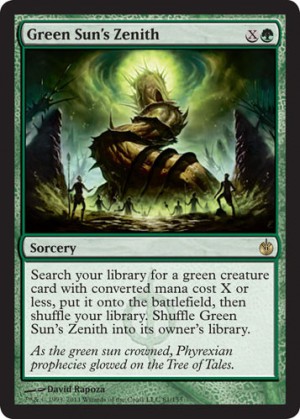
The reason for this is that the second best card in any of these decks just isn’t close in terms of power level. Sure, Squadron Hawk was good, but how many uncounterable Batterskulls did it come with? Cryptic Command was insanely powerful, but it didn’t actually kill your opponent. Geist of Saint Traft is a fine man, but you’ll find that he’s a lot easier to Mana Leak than Delver of Secrets.
I’m not saying that good players aren’t rewarded for playing well in Standard, but I do believe that the luck involved in Magic is more readily apparent in Standard than Extended, Modern or Legacy.
This being the case I find that having a well-tuned deck for a given weekend is of the utmost importance in Standard.
When it comes to larger formats I like the idea of playing very close to the same deck week in and week out to maximize your familiarity with it. This just doesn’t work as well in Standard. Some weeks you want to be Delving and some weeks you want to be jamming Garruk's Companion. I don’t even want to think about what I’m playing in a given Standard tournament until I've seen the results of the week before.
If you want the best deck for an event you won’t find it in the standings the week before. You won’t find it neatly nested in the latest article of your favorite pro. The only way to truly obtain the “best deck” is to build it yourself.
On Netdecking
Don’t get me wrong, playing the popular strategies of Standard is usually correct. That said, copying exact lists is usually wrong. The simple fact of the matter is that people are always ready for last week’s tech.
Take a look at the results from SCG Salt Lake City. Sure looks like Delver is the deck to play, right?
Now look at the results from the very next week in Des Moines. GR aggro is tough for Delver and this information was exploited by both finalists in this event.
Since then we have seen a fluctuation of the success of these two decks in the presence of metagames that are hostile to one or the other.
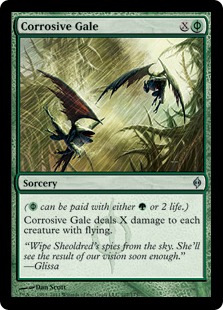
Remember the Pro Tour Dark Ascension Top 8? That Spirits deck sure looked real, until everybody (and I mean everybody) started siding Corrosive Gale. And did ramp fall out of favor immediately after or what?
You don’t want to be the one that shows up with last week’s Spirits only to lose to this week’s Corrosive Gales. You want to be the person that is casting the Gales. You want to be the person that innovates the Jace, Memory Adept tech against UB control. This is the difference between 0-2 drop and X-0-2 Top 8.
So what's the best way to do this?
Avoid Building with Large Groups
When it comes to deckbuilding, I’ve noticed that a lot of newer players will ask anybody who will respond for advice for their deck. This becomes a less fruitful exercise the better you get at the game.
The obvious reason for this is that the better you get at Magic, the fewer people with better opinions than yours there will be to ask.
The less obvious reason is that even amongst very strong players there isn’t always a consensus on what the optimal build of a deck is. Some players like Runechanter's Pike, some tend to Sword of War and Peace. Some prefer straight GR Wolf Run builds, while others would rather splash black or white.
An important thing to realize is that these ideas can’t always be hybridized. A mix of Pikes and SoWaP is fine, but Wolf Run splashing both black and white probably doesn’t work. The more differing opinions you incorporate into your deck-building process, the less likely you can successfully work them all into your build.
Different players have different playstyles and you don't want players with vastly different playstyles working on the same deck.
LSV is considered by many to be the best Magic player in the world. That said, he's not a stone master of all things Magic. Last December he posted a Running the Gauntlet video for Legacy RUG Delver. Let's just say that his play was a bit shy of perfect. During that series he tried to fit Thrun, the Last Troll into his sideboard. Meanwhile other players were moving away from Snapcaster Mage because it was too mana intensive.
Just because somebody is a great player that doesn't mean you want their opinion on every deck.
The Napkin Deck
Now for an anecdote.
Way back when there were still block constructed PTQs, I found myself with a group of Winona players at Perkins trying to build a deck for somebody that wasn't sure of how to build his deck.
The format was Lorwyn Block Constructed and he wanted to play GW Aggro. You would think that this would be an easy deck to hash out.
You would be very, very wrong.
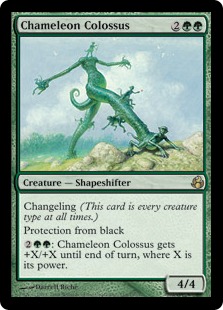
Heads butted for at least an hour on everything. The manabase. The spell suite. The sideboard. There were even people suggesting that obvious includes be cut.
I mostly kept quiet during the discussion, as there was no reason to raise my voice over a deck that I wasn’t going to play. Instead I asked my friend Jens if he had a pen I could borrow. After retrieving his writing utensil I began scribbling a potential UR control list.
I ended up with a pretty neat deck that featured Mulldrifter and Chandra Nalaar as the only win conditions. I considered playing it myself, but I had a Doran deck that I was pretty set on playing. I ended up shipping the list to Dan Skoglund.
The PTQ didn’t go well for me (actually, my story from this event is beyond embarrassing) but I was more interested in the contest between Napkin.dec and Greenwhitenonsense.dec. The GW deck ended up 0-2ing and Dan ended up missing top 8 when the wheels fell off after a 4-0 start. The list was strong but it was ultimately off by a few cards.
You Can’t Do It Alone
While I do advocate avoiding large groups, I also strongly recommend building with one or two other people.
The most success that I’ve ever had with a format was Extended during the PTQ season for PT Nagoya. I only played in two events this season. I Top 8’d both and won the second.
In order to prepare for this format I playtested everyday with Jon Amaro. Through our playtesting I personally had the chance to play with every deck that I thought was a major contender. This gave me a feel for which cards were and were not carrying their weight in every deck and gave me a lot of insight into which cards would be good to sideboard against each.
Problems arise when you get this information from other players.
The worst story I have in this regard was in preparation for PT Nagoya. We didn’t have a lot of time between the release of New Phyrexia and the Pro Tour itself, and this meant that some division of labor would be necessary to get the most information on the format possible. Everybody in the group focused on one deck specifically and was responsible for determining the best build of that deck.
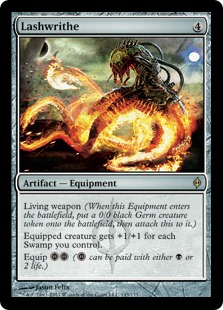
Brandon Nelson was our guy for Monoblack Infect, and he was immensely disappointing in this role. From the beginning we all encouraged him to include Lashwrithe.
He refused, citing that he "didn't like it.” For days he playtested with his build of the deck until Kyle Stoll decided to pilot it with Lashwrithe. It was quickly determined to be the best card in the deck, completely invalidating all of Brandon’s data.
I was personally responsible for working with Tezzeret, Agent of Bolas. I had been playing a Tezzeret Infect deck online prior to the NP release, but ultimately I came up with a UB control list (found here).
Most of the team ended up on my list, but many of those playing it didn’t spend any time questioning my card choices. The first reaction that many players gave me when receiving the list was to ask for a sideboard guide. To be fair, we didn’t have a great deal of time to playtest the list after I brewed it, but it was clearly off by a few cards.
Kyle Stoll and Martin Goldman-Kirst were the players that spent the most time messing around with my list before it was time to play and they offered some very good changes. Off the top of my head, Kyle is responsible for the maindeck Stoic Rebuttals and the sideboard Batterskull that were both very strong improvements over my original list.
The Process
This could probably be pieced together from reading the above, but for all the tl;dr-ers out there, here is a quick guide for how I approach a format:
Step One:
Be very familiar with how all of the decks in the format operate from both sides of the table. Knowing what your opponent is trying to do is essential to knowing how to play against them and how to build your sideboard for an event.
DON’T GET THIS INFORMATION SECOND HAND.
Even very good players are capable of being wrong. Of course, you should be aware of common opinions and be honest with yourself about why you think your opinion differs from that of others when it does. Just because you won 10 games running on one side of a matchup does not mean that the matchup is good.
Flukes happen and it’s important to recognize them when they do.
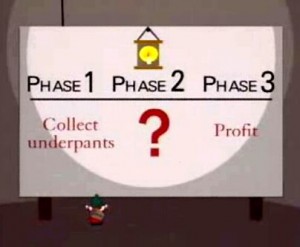
Step Two:
Be aware of what did well last week. Whichever strategies had success last week are likely to have a target on their head the following week. How exactly you adapt to this depends on the specific format, but it could be anywhere from completely avoiding playing last week’s deck to adapting the list from the week before to beat potential hate that is expected.
Step Three:
Come up with a rough list for what you want to play. You should come up with this list on your own so that your thoughts aren’t influenced by anyone else's bias.
Step Four:
Playtest your list to confirm or deny your thoughts on the cards in your build. Again, it’s very important to be honest with yourself in this phase. You can’t let the one time that you miracled Temporal Mastery eclipse all the times that it was a mulligan.
Step Five:
Send your list around and ask for suggestions. Hopefully the people you’re asking have been a part of your playtesting up to this point so that their suggestions are based on similar experiences.
From here you repeat steps four and five until you have a list that you’re happy playing.
~
My feelings about Standard may paint a gloomy picture, but I can’t understate the advantage that a player gains when they innovate new technology. I hope that you found this article helpful in reaching this end. Happy brewing.
-Ryan “The Dan ‘Wait that was probably too many oh God’ Broverton” Overturf






Great article.
Agreed. This was very good.
I had a great deal of success during that Extended season as well, thanks to our playtesting. Sure, I didn't win anything or even top 8. But I learned a valuable lesson: PUT DOWN THE NETTLE SENTINELS.
I like the emphasis you place on getting information firsthand. I don't think this can be stated enough. Whether it's metagame tech or matchup data, knowing how accurate your info is and WHY makes such a difference. DIY!
It’s appropriate time to make some plans for the long run and it is time to be happy.
I’ve learn this submit and if I may just I wish to suggest you some attention-grabbing things or advice.
Maybe you could write subsequent articles regarding this article.
I want to learn even more issues approximately it!